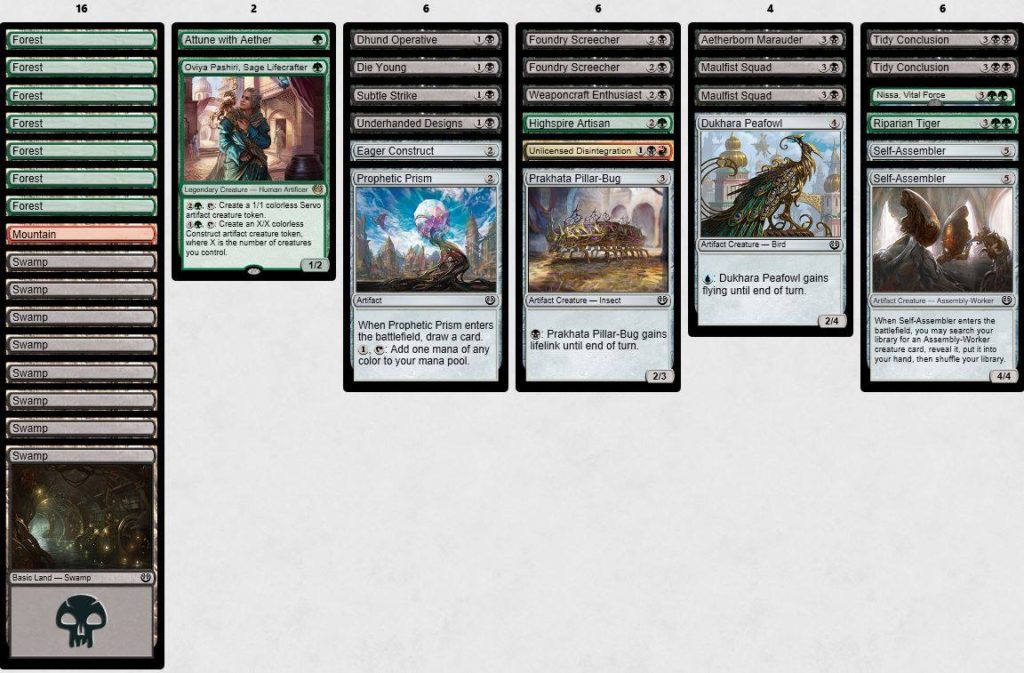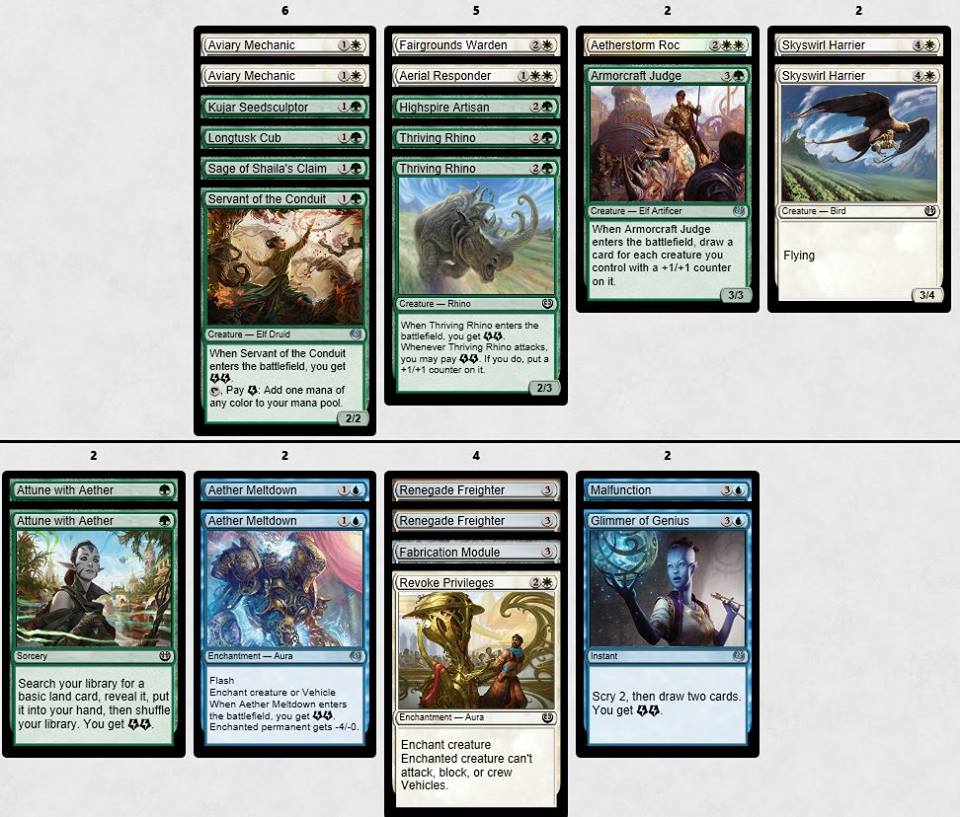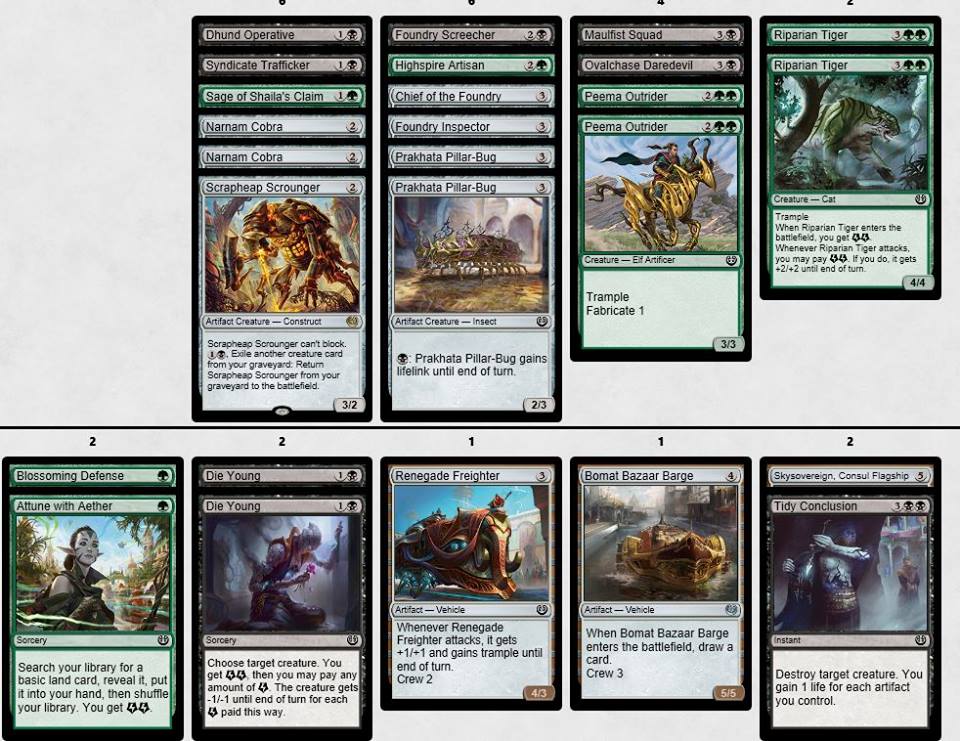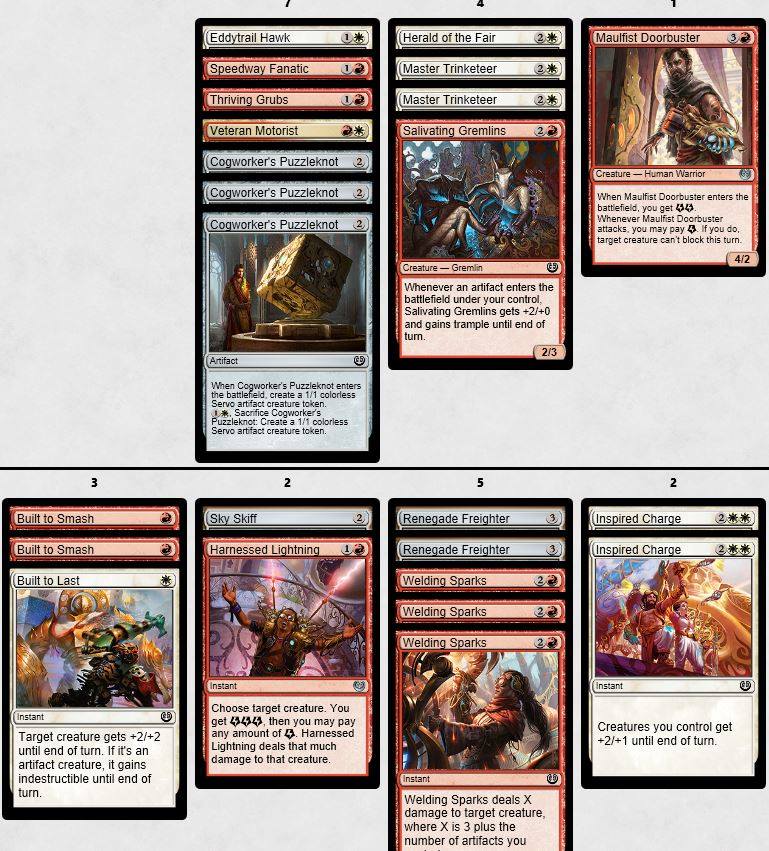I’ve been doing a lot of preparation leading up to GP Milwaukee this weekend. That isn’t generally hard to do because limited is my favorite type of Magic to play. That said, I’ve had some winning streaks and some losing streaks in this format. It has gotten to a point where it’s starting to feel like work to play more games, so I’m stopping to reflect on what I’ve learned heading into the tournament.
I’m going to start with discussion about Kaladesh specifically. But at the end I’m going to use Kaladesh as a jumping off point for a fun probability and statistics look at sealed formats in general.
Kaladesh Sealed Leagues
I did 25 Magic Online competitive sealed leagues to prepare for GP Milwaukee. I tracked my performance in the last 16 leagues for an overall record of 46-31 (60% win rate). I planned to go back and look through my decks and my opponents’ decks to sketch out a metagame of the most common archetypes. Unfortunately I did a clean install of MTGO this week which wiped out most of my match history. I do have my individual record for each of the last 16 leagues that I did, so I’ll break down which decks I had the most success with and talk about why others fell short.
Of my 16 recent leagues, here are screenshots of the six decks that went either 5-0 or 4-1:
GR Beatdown, 5-0
This was probably my best deck. The Wanderer was the last cut here to get to a 23 card deck. With seven 2-drops it beat down very consistently. It didn’t have a lot of removal, but the combat tricks were just as good at enabling great attacks every turn. The Self Assemblers were a great way to top off the curve – relevant bodies when your opponent is already under pressure and card advantage in one card.
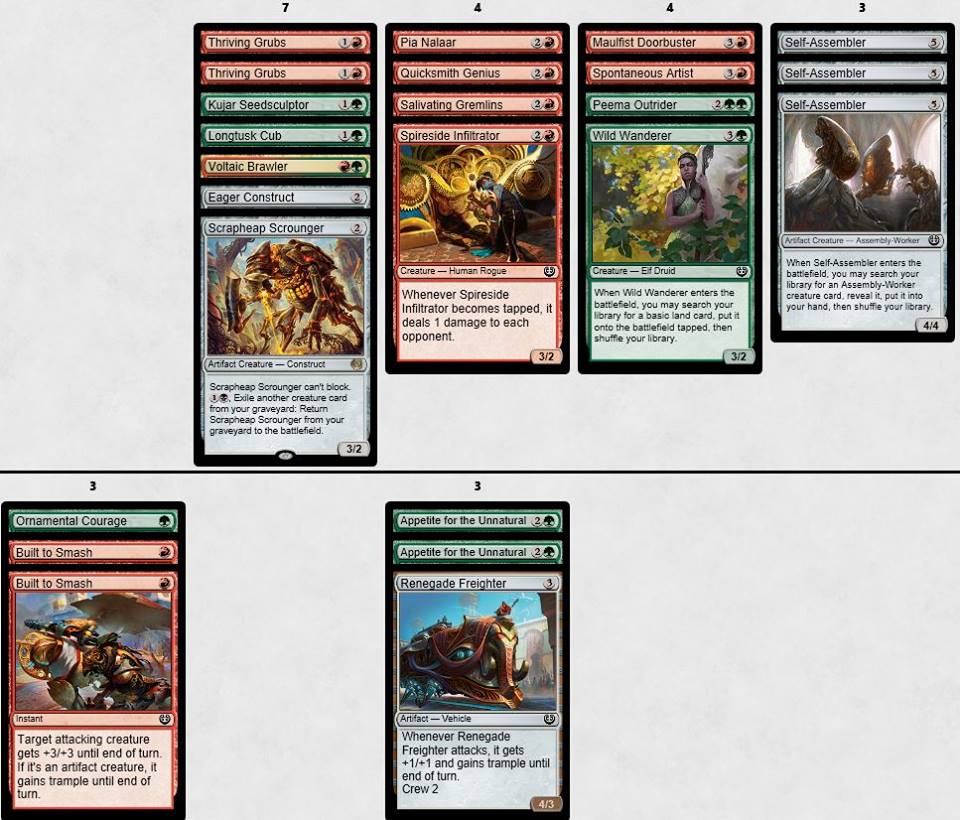
GBr Midrange, 5-0
This deck had the perfect mix of early plays, unconditional removal and late game card advantage. Having two prisms gives a lot of flexibility to splash the best removal spells. The prisms were especially good since I wanted artifacts for the Dhund Operatives. Of course, having a couple nice rares in the Smuggler’s Copter and Bristling Hydra helps too.
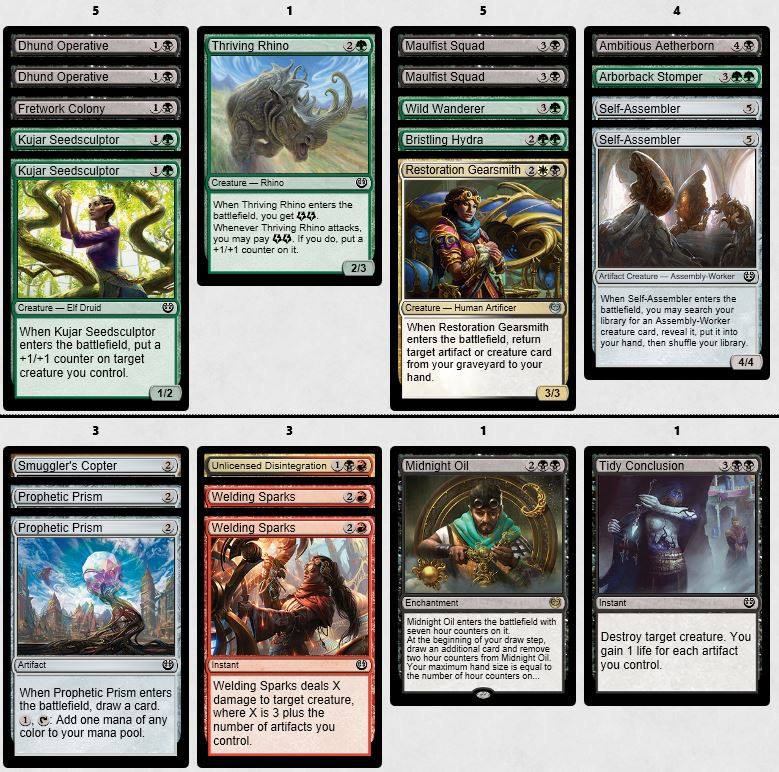
GBr Nissa, 4-1
This deck had the worst curve of all my successful pools. The curve skews high, but the deck had enough unconditional removal and a couple of bomb rares to take over games. This pool was convenient since one color was deep enough that I could choose any support color. In that case, you can choose whichever color provides the most bombs or fills the gaps of your primary color. This is something to watch out for in a set that has a lot of playable artifacts. Of note, the Dukhara Peafowl fills a hole in the curve here. I like the card a lot, especially in Prism decks as an effective blocker. Being colorless is important if your mana fixing doesn’t come together in the early turns and later you can get the activation for free off of a Prism to block flyers.
GWu Energy, 4-1
This deck felt great. It had some good beat down draws and some strong flyers for the late game. A pool with two Attune with Aether that also makes use of the energy gets to splash for free. Here I needed the blue for removal spells. Not shown, I also ended up splashing a Saheeli’s Artistry. It was a little hard to cast, but with double Attune, Servant of the Conduit and an Aether Hub, I had just enough sources to be happy that I included it. All this deck was missing was a Prophetic Prism to make the mana a little better and to combo with the Aviary Mechanics.
GB Midrange, 4-1
This was a very boring and very solid midrange deck. It may not be a surprise to see a Skysovereign, Consul Flagship deck go 4-1, but I think I only cast the card one time. The GB beatdown curve was just very consistent. Whenever I payed a Scrounger on turn 2 I felt like I was so far ahead. Not a lot of removal here, but my curve was good enough and creatures large enough that I was able to overpower most of my opponents. This was a perfect deck for the vehicles since I have fewer spells and many big bodies ready to crew.
RW Tokens, 4-1
I was not happy when I opened this pool and found this to be my best option. The pool was desperately short on creatures in all colors. Two Master Trinketeer is awesome, but I didn’t think I had enough support to make them good. This was the color combination that I had my highest number of creatures and even this build only had 13 creatures – and that’s if you count Cogworker’s Puzzleknots! I added a Siege Mastodon over the second Inspired Charge below to get up to 13 creatures. This result really drove home the power of 2-drops in the format. I was able to play cheap creatures and use my spells to end games quickly. What the deck lacked in creatures, it made up for in good removal and combat tricks.
What Did I Learn From These Successful Decks?
The lesson that has been the loudest over the course of testing is the importance of 2-drops. Of these six decks, all but one of them have 5-7 two drop creatures plus some cheap removal spells. Two of these were true aggro decks (GR and RW). The other three were midrange decks, but they still had a good curve that started at 2. If you don’t open an aggressive beatdown pool, you at least have to realize that those decks exist and be prepared to beat them. This is not a format where I want to be on the draw. If I had a pool without a lot of 2-drops I think I’m at the point where I would actually consider looking at cards like Incendiary Sabotage to help me catch up from behind. Hazardous Conditions is also a sideboard card to keep an eye on if you are desperate.
Gx-splashing removal is one of the more consistently strong archetypes. Green provides a lot of well-costed creatures all the way up the curve at common. It also has two common mana fixers in Attune and Wild Wanderer. Pairing Green with another other color and splashing for removal from a third is an easy way to have a strong midrange deck. I would choose whichever second color is going to fill out a good consistent curve and hopefully offer a strong rare. The most common of these decks is GB splashing red removal.
Common Sealed Archetypes
Green-based 3 or 4 color decks. These will feature some mix of Attune with Aether, Wild Wanderer and Prophetic Prism as mana fixing. If you have the fixing, feel free to take advantage of it and build a deck that leverages the rares and removal from 3-4 colors. However, you still need to be ready to play defense starting on turn 2. In this format you can’t have a clunky curve that starts on turn 3 and risks stumbling on colors or amounts of mana. Having great fixing doesn’t mean you should fill your deck with expensive bombs. Your deck should still have a normal looking curve starting at 2; you just have the additional flexibility of filling that curve with cards from more colors. I’ve played pools that had the fixing to support 3-4 colors worth of bomb rares, but when your high impact spells are all 5 or 6 mana you may not get the chance to even cast them.
2-Color Midrange. These are usually also green based because the green commons are so strong. You will end up here if you have 2 colors that are deep so there’s no need to splash, or if you just don’t have any mana fixing. Often this will end up playing a bunch of green creatures and whichever color gives you good removal and fills your curve. I’ve had a lot of pools that just end up playing a pile of Green-Black good cards. I also like Green-Red and Black-White. While Green-White is a pair I’ve had less success with, it can work if you get enough removal in white.
Red-based aggro. I’ve played Red-Green, Red-White and Red-Black aggressive decks to good success. I’d be happy with any pool that can put a good curve together with 6-7 good 2-drops backed up by 3-5 combat tricks and removal spells. It’s not uncommon to be able to play 16 lands in such a deck. In a pool like this, I’m willing to play some filler 3-drops like Lawless Broker or off-color artifact creatures like Narnam Cobra just to have enough warm bodies to get over the finish line. Eager Construct is a staple of these types of decks as a common that can go in any color pair to reach the critical number of 2-drops needed. It smooths your draws and is especially great with Built to Smash.
Blue rares. Blue is just a generally weak color. Almost every blue deck I’ve played with or against played blue only because they had some powerful rares in the color. If one of my opponent’s main colors is blue, I expect them to have Confiscation Coup, Saheeli’s Artistry or Aethersquall Ancient. It’s possible some people will play blue if they have multiple Gearseeker Serpents but I’ve found that I usually don’t have enough artifacts to make the Serpents great or I have better cards in other colors. Usually blue will get paired with Green in a 3-color or energy shell. A blue splash is usually for energy cards like Whirler Virtuoso, removal or Cloudblazer.
Notes on Specific Cards
I’ll talk more about the odds of seeing specific cards later, but here are some cards I’m keeping my eye on in the format.
Cards I’m hoping to open.
I’m just talking about commons and uncommons here. Rares are great, but since we can’t always get lucky I’m not going to spend any time hoping for specific ones.
Prophetic Prism, Attune with Aether. Great mana fixing can be the foundation of a really strong pool. If you open good cards in 2 colors, congrats, it will be an easy deck to build. If your good cards are spread across 3-4 colors, you’ll still be able to pull it off if you have good mana fixing. So pools with great fixing are more likely to be able to play all their best cards.
Appetite for the Unnatural. This card has lots of great targets in the format – I’d play two in nearly every green deck if I had them. At instant speed, it’s one of the most efficient removal spells to have. In sealed every good colorless card that gets opened will go into a deck, no matter what color that person plays. More on that later.
Renegade Freighter. This can win a game by itself if left unanswered and will go in every deck.
Artifacts. Having access to a lot of premium artifacts gives you a lot of flexibility with your deck building. These are cards like Chief of the Foundry, Foundry Inspector, Snare Thopter, Filigree Familiar, Renegade Freighter, Sky Skiff. If you have 6-7 colorless cards, that means you only need to find 16-17 other playables. With artifact creatures you can play a color that has some great removal and rares, but isn’t very deep.
Self-Assembler. Here’s one artifact I want to give special attention to. There’s nothing sadder than opening a pool with a single Self-Assembler. But if I open multiples, it does everything I want in sealed. They’re colorless, which keeps me flexible on my colors, but they also provide card advantage on a good sized body.
Welding Sparks. It’s the best common removal spell and I’ll often splash it if I’m not playing red.
Restoration Gearsmith. Black-white is a candidate for the best 2-color combination that doesn’t include green. If I have a Gearsmith in my pool, I will usually do my best to at least splash it. The value here is just too good not to try to find a way. It’s value goes up in sealed because you will hopefully have rares in your pool that you want to rebuy.
Cards I want to have a plan for.
Renegade Freighter. Just about every Freighter that gets opened will make its way into a deck. It’s powerful and colorless, and if you don’t have a way to deal with it it will kill you quickly. This card is part of the reason that I want to main deck x2 Appetite for the Unnatural if I have them in my pool. Fragmentize is less flexible, but I would still play at least one, depending on my other removal.
Longtusk Cub. I’ve already said 2-drops are important and here’s another great example why. If you get behind on board to an early Longtusk Cub, it’s going to be really hard to win. Deathtouchers or enough 2-powered 2-drops that can trade on curve are important here.
Smuggler’s Copter. Every copter will be in a deck. This is another example of why Appetite and Fragmentize are so important.
Note: Impecable Timing isn’t a great card, but I don’t mind playing it if I am short on answers to these problem threats. It kills Freighter, Cub and Copter on curve. The problem is that it’s easy to play around. That said, I try to play around Timing in the early turns of the game as much as I can.
Fumigate. Fumigate will be a large incentive play white, which is already a decent color in a lot of pools. Even though it’s a rare, everyone will be playing their best cards and colors. It’s not something to play around in the dark, but if the way your opponent is playing or the way their deck is built gives you a reason to think they might have a Fumigate, you are probably right.
Probabilities and Sealed Pools
Now I’d like to get into some statistics on how likely you are to see specific cards in any given sealed pool. This is a topic that could spawn an entire article, but I’ll try to get to some key points. This is partially just a mental exercise, but it can inform our decision of when to play around a specific card or how many times you can expect to play against a specific set of cards in a tournament.
The Kaladesh set contains 101 commons, 80 uncommons, 53 rares and 15 mythics. From this we know the odds of opening any one specific card in a booster pack (each pack contains 10 commons, 3 uncommons, and one rare or mythic – I’m ignoring foils for this analysis). Once we have the odds per booster, we can use this to figure out our odds of opening a specific number of copies of a certain card in a 6-booster sealed pool.
Odds of a Specific Card In a Single Booster:
Common: 9.90% (10/101)
Uncommon: 3.75% (3/80)
Rare: 1.65% (1/53*7/8)
Mythics: 0.83% (1/15*1/8)
Odds of a Specific Number of Copies of a Card In a Sealed Pool
Common: 0 copies (53.5%), 1 copy (35.3%), 2 copies (9.7%), 3+copies (1.5%)
Uncommon: 0 copies (79.5%), 1 copy (18.6%), 2+ copies (1.9%)
Rare: 0 copies (90.5%), 1+ copy (9.5%)
Mythic: 0 copies (98.6%), 1+ copy (1.4%)
So this is saying I have an 11.2% chance of opening the two or more Renegade Freighter, two or more Prophetic Prism, or two or more Self-Assembler pool I’m hoping for (and I’m 35% to open the dreaded singleton Self-Assembler). Your opponents also have a 11.2% chance of opening two or more Renegade Freighters. That means over a 9 round tournament, you can expect exactly one of your opponents, on average, to have multiple Freighters in their deck.
How can we use this information? Let’s talk about some examples.
Given that I’ve already seen one copy of a card, should I play around a second copy?
Let’s say my opponent as already cast an Impeccable Timing or Blossoming Defense this game. Have you ever thought, ‘Well, what are the chances they have another one here?’ I know I have, and we can figure that out. If they’ve already cast one copy, we know they are playing that color and have put that card in their deck. We’re going to make the assumption that if they want to play one copy of the card, they are going to play two copies of the card if they opened it. [Note: This isn’t strictly true as some situational spells and combat tricks may only be played as a one of, even if you have access to multiples, but it’s a reasonable starting point for an estimate.]
Since we’ve already seen one copy, we can eliminate the probability that our opponent has opened zero copies. Now we just have to figure out if they opened exactly 1 or more than 1. [For the math fans, we use Bayes’ theorem to get the conditional probability that our opponent has a second copy, given that they have shown us that they have at least one.]
Odds Opponent Has a Second Copy of a Card, Given That We’ve Already Seen One Copy
Common: 24.1%
Uncommon: 9.3%
To me, this was a surprisingly high result. If my opponent killed my Thriving Grubs on turn 3 with an Impeccable Timing, they are actually still almost 25% likely to have a second Timing in their deck that can kill my Renegade Freighter. Whether they’ve actually put it in their deck or drawn it is a different matter, of course.
How likely are you to face an opponent on Day 1 of a GP that has <insert great card here>?
Let’s say that with an unknown sealed pool every color is equally likely to see play – each color is about 40% likely, assuming a 2-color deck. But powerful rares are a strong draw to playing a particular color in sealed. If the only thing I know about my pool is that it has a Fumigate, then I would say my odds of playing white are much higher than any of the other colors.
Let’s say that if I open a Fumigate, now my odds of playing white go from 40% to 60%. That means 60% of all Fumigates that get opened will end up getting registered in a deck. We know that a sealed pool is about 9.5% likely to open a Fumigate in the first place. This means that any given sealed pool is 5.7% (0.6*0.095) likely to have a Fumigate registered in the final deck. When I sit across from a random opponent (who opened a random sealed pool), these are the odds that they have Fumigate in their deck: 5.7%.
Over the course of a 9-round tournament, you can expect to play against 0.5 Fumigates (or rather, 0.5 decks that have Fumigate in them).
But the free information doesn’t stop there. Once your opponent plays a Plains and they show that they are playing white as a core color, they are now more likely to have a Fumigate than if they were playing something like Red-Green. Again we are using Bayes’ theorem here. We made some assumptions and pegged a random sealed pool to have a 5.7% chance of playing Fumigate. But what are the chances that a random sealed pool is playing Fumigate given that our opponent is choosing to play white as one of its core colors?
Based on the assumption that 40% of sealed pools will end up in white, we can actually say that our opponent who starts on a turn 1 Plains is about 14.2% (0.057/0.40) likely to have Fumigate in their deck.
We can adjust these numbers based on the relative strength of the colors, if we want to be more rigorous about it. Blue is generally considered the worst color in Kaladesh sealed, so let’s say that it only gets played 20% of the time, instead of the 40% that we assumed earlier. If someone opens Confiscation Coup, maybe that makes blue 40% likely to see play instead of 20% (essentially on par with the other colors). Here we would say that a Confiscation Coup is 9.7% to be opened, but now it’s only 3.9% to be opened and registered in a deck (compared to Fumigate’s 5.7%). This is where we gain the most information from the lands that our opponent plays. If our opponent plays an island, we’ve learned a lot more about their deck than if they played a plains. Since very few people play blue, they must have an incentive for doing so. Using Bayes’ theorem again, we in fact see that given only 20% of random pools will play blue, our blue opponent is now 19.4% likely to be playing a Confiscation Coup (0.039/0.20).
How does this change when we’re talking about a colorless card, like Smuggler’s Copter? Every deck will play it, so now the math is more straight-forward. A pool is 9.5% to open it. If a Copter is opened, it’s going to get played 100% of the time, so a random sealed pool is 9.5% likely to register a Smuggler’s Copter. In a 9-round tournament, you are going to play against, on average, 0.86 Smuggler’s Copters. In this case, what lands our opponents plays does not give us any additional information. For this reason, it’s actually harder to play around a colorless card like Fleetwheel Cruiser than a colored spell like Fumigate.
While we’re talking about colorless cards, every single first copy of Renegade Freighter is going to be in someone’s deck. That means 46.5% of your opponents will have at least one Freighter that you need to be able to beat.
How many good targets will the average sealed pool have for Appetite for the Unnatural
This is the last example I want to look at. I’ve said that I like playing two Appetites if I have them. It has ‘felt’ good, but I’d like to see what the numbers can tell us. Here the math is a little easier because for artifacts there are no conditional probabilities related to the color of our deck. Every deck can play a good artifact.
I’ll start with a list of Appetite targets that nearly 100% of decks will play if they open them. These are the best artifacts and top-tier targets.
Common: Renegade Freighter
Uncommon: Snare Thopter, Chief of the Foundry, Foundry Inspector
Rare: Cultivator’s Caravan, Smuggler’s Copter, Fleetwheel Cruiser, Key to the City, Multiform Wonder
We expect 0.1 copies of each rare in a sealed pool, so these five rares contribute 0.5 targets to an average sealed pool.
We expect 0.23 copies of each uncommon in a sealed pool, so these three uncommons contribute 0.7 targets to an average sealed pool.
We expect 0.6 copies of each common in a sealed pool, so this one common contributes 0.6 targets to an average sealed pool.
From just this category of cards, we can expect 1.8 targets in an average pool
There are other, less powerful artifacts. Let’s say that these artifacts get played in 50% of all pools they are opened in.
Common: Sky Skiff, Eager Construct
Uncommon: Bomat Bazaar Barge, Ovalchase Dragster, Fabrication Module, Filigree Familiar, Iron League Steed
Rare: Animation Module
We expect 0.1 copies of each rare in a sealed pool, so this rare (played half the time) contributes 0.05 targets to an average sealed pool.
We expect 0.23 copies of each uncommon in a sealed pool, so these five uncommons (played half the time) contribute 0.58 targets to an average sealed pool.
We expect 0.6 copies of each common in a sealed pool, so these two commons (played half the time) contribute 0.6 targets to an average sealed pool.
From this category of cards, we can expect an additional 1.23 targets in an average pool.
Let’s also assume that each 2-color deck plays all of its on-color artifact creatures (Weldfast Monitor, Narnam Cobra, etc). This adds 2 more commons to our ‘100% played’ list, and adds a total of 1.2 targets.
From just these category of cards we are looking at a total of 4.23 targets for our Appetite of the Unnatural. And this doesn’t include enchantments like Revoke Privileges and Malfunction, or specialty artifacts and enchantments like Dynavolt Tower, Era of Innovation or Decoction Module.
Conclusion
As you can see, I’ve played and thought about Kaladesh sealed a lot over the last month. I wish I had been more rigorous in keeping track of my sealed testing as I played it, rather than going back after the fact and trying to pull information out of the decks. In any case, I am looking forward to cracking open a sealed pool on Saturday and finally seeing what I’m going to have to work with.
You may have noticed that I didn’t talk about draft. Well that’s because I still don’t have a grasp on the format. I’ve had a lot of success with black based artifact decks of all types (BG, BW, BR – not BU). I know I prefer to be attacking and I would be happy ending up in any of these black decks, but I’m struggling with tunnel vision on only those archetypes. That reminds me, it’s about time for me to go do a draft and see if I can learn about other archetypes! If things go well, I hope to have the opportunity to crack some boosters on Sunday.
Follow me on Twitter @thenatewalker.
Follow my Twitch channel: www.twitch.tv/n_walker. I stream a lot of limited, some standard/modern.
Or reach me in the comments below!

